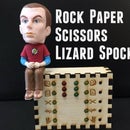Introduction: IR Periscope
I hate exposed wires! You buy a beautiful TV that hangs on your wall and then you have wires running to it, up your wall that ruin it all! Well there are plenty of solutions out there for running wires inside of walls and all that. But that's not what I'm here to show you.
Once you have all those wires hidden you still have your components that need an IR signal. There are plenty of solutions for this, many that are high dollar and fancy that I have willingly employed throughout other rooms in my house where the application fits. But for this application, my bedroom, there are only a few components that need to be hidden and only a dresser to hide them behind.
I will show you how I concealed my Apple TV and cable box. And in the case of my cable box, worked around how to maintain IR control.
Step 1: Hang Your Beautiful TV on Your Wall
Ok, not really going into any detail here. Hang your TV if you haven't already done so. Conceal your wires down to floor level. I ran 2 HDMI cables plus power through the wall and out near the baseboard. It was some $20 kit that made all the electrical work UL legit and up to code. Do yours as you please.
Step 2: Strange Your Components
Man, that dresser looked a lot better before it had these two devices sitting on top of it with wires hanging down. From the side you really see the wires and it just doesn't look professionally done. I had to come up with a solution to hide these things!
Step 3: Mount Your Components
Given that I had a dresser right below the TV, already covering where the cables came out near the baseboard, why not hide them there?
I thought of putting them in a drawer, but didn't want to sacrifice storage. Plus, then the IR signal wouldn't be able to get there without a repeater. More cost, more wires!
I thought of mounting them in the room behind the TV, but that common wall wasn't well suited for the purpose. Once again, IR repeated needed.
I finally settled on mounting them to the back of the dresser. Easy solution and they are thin enough components to not have the dresser stick out more that two inches.
A few measurements later I went to the garage and started creating my "brackets". A few thoughts/recommendations here.
- I settled on using peg board. I had scrap laying around and thought the perforations would help with airflow.
- Look carefully where your cables plug in. Don't block any cable ports needed with your mounting hardware.
- Measure twice, cut once. Always saves frustration.
15 minutes later I had mounting brackets that held my components perfectly. The cable box and Apply TV now sit just behind the dresser and can't be seen from the front, and not really from the side either. The tops with their IR receivers sit just a hair below the top surface level of the dresser.
Step 4: Looks So Much Better! But Does It Work?
Wow, that looks so much better! But does it work?
Apple TV - check. This device works great with just pointing the remote at the TV and the signals bounce down to the box just fine. Nice!
- Cable Box - blah. The cable box is super sensitive to getting an IR signal head on apparently. So this got me thinking. What is a simple solution to improve the IR reception?!?
Step 5: The IR Periscope!
The thought popped in my head and a visit to the kids art supplies and kitchen later I had my solution. I crafted a sort of IR reflector out of construction paper and aluminum foil.
The build:
This is simply just two quarter circles with radii of approximately 1 inch. A piece of paper 1 inch wide with a length equal to the circumference of the quarter circles. (2*pi*R*0.25) for those of you that didn't pay attention in school.
Slap some tape on it as shown to create the rounded hood shape. The take your small piece of aluminum foil and tape it inside alone the curved piece leaving the shiniest side exposed.
Tape this over the IR receiver of your component and BAM! Custom solution that is far cheaper and more effective than anything sold commercially.
Step 6: Finished
Now all that is visible is a half inch or so of our IR periscope with everything else hidden away. A quick, easy solution to hiding your components. This thing works great and keeps the dresser looking clutter free!
Thanks for reading. Check out my other, normally more sophisticated, Instructables!

Participated in the
Reuse Contest

Participated in the
Crafting 101

Participated in the
Home Automation













